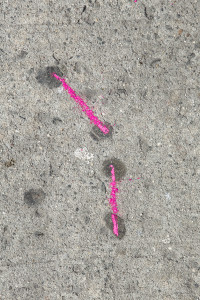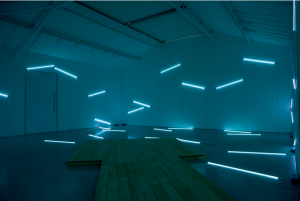Bita Fayyazi’s work is disquieting; massive cockroaches swarm and inelegant thread bound heads jut from walls, smashed figures squat on low podiums and terracotta dead dogs lie on piles of dirt. Yet, almost against aesthetic reason, the pieces are utterly compelling.
Her third solo outing at Gallery Isabelle van den Eynde is a reinterpretation of her career from the perspective of Dubai-based, Tehranian brothers Ronki and Ramin Haerizadeh. Rearranged lights upon iconic moments to realise an illuminating cross section of Fayyazi’s works, revealing a fervent body of processes and mediums.
The Haerizadeh take-two does not attempt to structure Fayyazi’s career narratively – neither chronology nor a curation of her disciplines and mediums are the key to understanding the particular quality of her work. Instead, the arrangement thrives on multiplicity, embraces the noise of her diverse practice to demonstrate why an act of rearrangement is so particularly relevant to this career and this artistic oeuvre.
Cockroaches, 1998, Glazed ceramic and metal wire, 1500 pieces
Cockroaches are ritual ritualised – the mass of giant vermin crawl the walls and pile up on the floor. This was a reality for Fayyazi; for a year she looked after a neighbours apartment and swept away real cockroaches as they appeared and died. Her creative process was launched from the end of this daily reality; following her neighbours’ return the cleaning ritual was aborted. In its place she began to create her oversized animals, ritual-like, summoning their presence where their absence now was, and she continued to make them until there were thousands.
The making of this mass involved a mass of people making, too, as she began to employ others in their creation. The process began with a compulsive personal creation which become an act of direction – a framework in which she harnessed the creative energy of others to realise a grander pattern, seemingly emerging through un-premeditated action. The cockroaches are one mass but a varied multitude, appearing as a whole whilst many. Fayyazi directs, many make and Fayyazi realises the potential in this resultant creative mass.
Untitled, 2014, branches, yarn, recycled packaging
This process is even more pronounced in the collection of wool bound pieces Head of Horns and the Untitled figurines, serialised but with each piece more autonomous than the mass of cockroaches. Those displayed here are from an in-progress, site-specific work in Tehran. Again she assumes the role of director, with residents filling the rooms of an historic house with hand-made tightly bound figures of scrap and industrial waste. Methodologically, these pieces can be traced to earlier works, the pattern having emerged from a similar compulsive and unplanned act, where wool binding was the articulation of a certain unacknowledged frustration for the artist. This evolved into a motif and technique which later became this act of creative direction. Again, she forges the parameters within which the participants make, liberating her own process from a sense of authorship to initiate something larger. She is the first mover in the rearrangement, rearranging her own work processes through relinquishment, and then rearranging other people’s creative outputs to realise a somewhat unplanned whole.
Head of Horns, 2014, yarn, galvanized tubing, fiberglass and tree bark
The rearrangement of her career by the Haerizadeh brothers can be read as the ultimate relinquishment of creative force, and it is illuminating in its appropriateness. The processes and the participatory nature of each work retain their inherent creative energy – testament to the power of the process she has instigated. The latent power of her work – often social, many times having altered the parameters of artistic practice in Tehran – are like a creative circuit board consistently illuminated through engagement. Even the terracotta dead dogs buried in the ground retain their urgency years after she first performed their dying and interment in Tehran.
Road Kill, 1998, glazed ceramic, sand and neon
Road Kill, 1998
This is more than rearrangement; the works themselves invite the act, and almost demand to be re-approached. It’s a re-ignition, which, like something alchemical, makes new. What is her creation then? Both the object itself and the process she initiates, the energy she actualises – whether herself or through others – and the energy she once directed sustains a creative process that is brilliantly and compellingly continued here.












